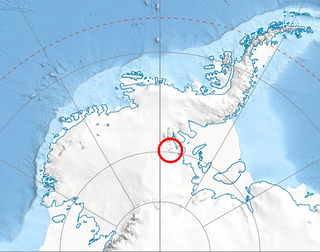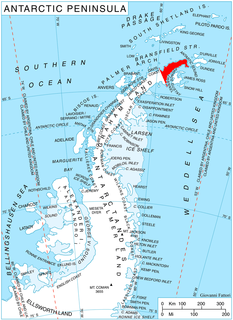Williamson Ridge is a low snow-covered ridge, 10 nautical miles (18 km) long and 2 to 5 nautical miles (9 km) wide, that forms a western extension of Toney Mountain in Marie Byrd Land. It was mapped by United States Geological Survey (USGS) from ground surveys and U.S. Navy air photos, 1959–71. Named by Advisory Committee on Antarctic Names (US-ACAN) for Paul R. Williamson, ionospheric physicist at Byrd Station in two austral summers, 1967–68 and 1969–70.
Anderson Ridge is a ridge 2 nautical miles (4 km) long, rising above the middle of the head of Koerwitz Glacier in the Queen Maud Mountains. It was mapped by the United States Geological Survey from ground surveys and from U.S. Navy air photos, 1960–64, and named by the Advisory Committee on Antarctic Names for Arthur J. Anderson, a meteorologist with the South Pole Station winter party, 1960.
Bevin Glacier is a glacier 5 nautical miles (9 km) long, which flows east from the plateau escarpment on the east side of Graham Land into the northwest end of Cabinet Inlet between Attlee Glacier and Anderson Glacier. During December 1947 it was charted by the Falkland Islands Dependencies Survey (FIDS) and photographed from the air by the Ronne Antarctic Research Expedition. It was named by the FIDS for Rt. Hon. Ernest Bevin, M.P., British Minister of Labour and National Service and member of the War Cabinet.
Buddha Rock is a rock, 35 metres (115 ft) high, lying 0.3 nautical miles (0.6 km) west of Vindication Island in the South Sandwich Islands. It was charted and named in 1930 by Discovery Investigations personnel on the RSS Discovery II.

Orion Massif is a prominent massif located in Palmer Land, Antarctica. It is 14 nautical miles long and consists of a complicated network of peaks, passes, ridges, and cirques. It is located 4 nautical miles east-northeast of Scorpio Peaks, between the upper parts of Meiklejohn and Millett Glaciers, and 5 nautical miles south of Goettel Escarpment.
Cope Hill is a hill 1 nautical mile (2 km) west of Manfull Ridge on the north side of the Kohler Range in Marie Byrd Land. It was mapped by the United States Geological Survey from surveys and from U.S. Navy air photos, 1959–66, and named by the Advisory Committee on Antarctic Names for Lieutenant Winston Cope, MC, U.S. Navy Reserve, Medical Officer at the South Pole Station, 1974.
Jones Nunatak is a nunatak at the head of Noll Glacier, 4 nautical miles (7 km) west of Mount Schutz, in the Wilson Hills of Antarctica. It was mapped by the United States Geological Survey from surveys and U.S. Navy air photos, 1960–63, and was named by Advisory Committee on Antarctic Names for Frank E. Jones, Aviation Boatswain's Mate of U.S. Navy Squadron VX-6, a member of the aircraft ground handling crew at Williams Field, McMurdo Sound, during Operation Deep Freeze 1967 and 1968.
Dory Nunatak is an isolated sandstone nunatak, 1.2 nautical miles (2.2 km) long, rising above the southwest part of Flight Deck Neve, 1.5 nautical miles (3 km) southwest of Dotson Ridge, in the Convoy Range, Victoria Land. One of a group of nautical names in the Convoy Range, it was so named by a 1989–90 New Zealand Antarctic Research Programme party because the feature appears to be sailing in the midst of the glacier névé like a small dory type boat.
Eastwind Ridge is a broad, partially ice-covered ridge about 10 nautical miles (20 km) long between Chattahoochee Glacier and Towle Glacier in the Convoy Range of Antarctica. It was mapped by the United States Geological Survey from ground surveys and Navy air photos, and was named by the Advisory Committee on Antarctic Names in 1964 for the USCGC Eastwind, an icebreaker in several American convoys into McMurdo Sound since the 1958–59 season.
Elsner Ridge is a narrow, southwest-trending ridge, or spur, 6 nautical miles (11 km) long, located 4 nautical miles (7 km) northeast of the south end of the Homerun Range in the Admiralty Mountains of Victoria Land, Antarctica. It was mapped by the United States Geological Survey from surveys and U.S. Navy, aerial photographs, 1960–63, and was named by the Advisory Committee on Antarctic Names for Robert W. Elsner, a United States Antarctic Research Program biologist at McMurdo Station, Hut Point Peninsula, Ross Island, 1967–68, 1968–69 and 1969–70. The ridge lies situated on the Pennell Coast, a portion of Antarctica lying between Cape Williams and Cape Adare.
Montgomerie Glacier is a narrow tributary glacier, 10 nautical miles (19 km) long, flowing north along the west side of Hampton Ridge in the Queen Alexandra Range of Antarctica to enter Lennox-King Glacier. It was named by the Northern Party of the New Zealand Geological Survey Antarctic Expedition of 1961–62 for John Montgomerie, assistant surveyor of that party.
Hudson Ridge is a narrow rock ridge 5 nautical miles (9 km) long, lying 4 nautical miles (7 km) north of Heiser Ridge in the Neptune Range of the Pensacola Mountains, Antarctica. It was mapped by the United States Geological Survey from surveys and U.S. Navy air photos, 1956–66, and was named by the Advisory Committee on Antarctic Names for Peter M. Hudson, an aviation machinist at Ellsworth Station, winter 1958.
Masquerade Ridge is a prominent rock ridge, 5 nautical miles (9 km) long, located 16 nautical miles (30 km) north of Clarkson Peak on the east side of Robb Glacier, Antarctica. Rocks were collected here by John Gunner and John Splettstoesser in December 1969. The name was suggested by Gunner because the ridge is pictured on the cover of the February 7, 1970 issue of Saturday Review, in which an article about the 1969–70 Ohio State University Geological Expedition to the general area appears. The ridge on the photograph was evidently confused with Coalsack Bluff, and the individual in the foreground of the photograph is not David Elliot, as the caption states.
Hochstein Ridge is a ridge 12 nautical miles (22 km) long, extending north from Cotton Plateau between Prince Edward Glacier and Prince of Wales Glacier in the Queen Elizabeth Range of Antarctica. It was mapped by the United States Geological Survey from tellurometer surveys and Navy air photos, 1960–62, and was named by the Advisory Committee on Antarctic Names for Manfred Hochstein, a United States Antarctic Research Program glaciologist at Roosevelt Island, 1961–62, 1962–63 and 1963–64.
Hinckley Rock is a rock 4 nautical miles (7 km) northwest of Gillies Rock in the northern Neptune Range of the Pensacola Mountains, Antarctica. It was mapped by the United States Geological Survey from surveys and U.S. Navy air photos, 1956–66, and was named by the Advisory Committee on Antarctic Names for Neil Hinckley, a member of the Electronic Test Unit in the Pensacola Mountains, 1957–58.

Henderson Glacier is a glacier about 7 nautical miles long in the Enterprise Hills of the Heritage Range, Antarctica. It flows northeast from Schoeck Peak and Hoinkes Peak to enter Union Glacier just east of Mount Rossman. Henderson Glacier was mapped by the United States Geological Survey from surveys and U.S. Navy air photos 1961–66, and was named by the Advisory Committee on Antarctic Names for Felix E. Henderson, a United States Antarctic Research Program meteorologist at Eights Station in 1965.
Hulbe Glacier is a glacier about 10 nautical miles (20 km) long draining the north side of Siple Island, Antarctica. It was named by the Advisory Committee on Antarctic Names after Christina Hulbe, faculty member of the University of Otago, New Zealand, and a theoretical and field researcher of ice motion in Antarctica.

McCalman Peak is the 550-metre (1,800 ft) summit of an east–west trending ridge 3 nautical miles (6 km) north of Crystal Hill, 3.97 km east-northeast of Gornik Knoll, 6.9 km south-southeast of Kumata Hill and 4.55 km west-southwest of Zaldapa Ridge on Trinity Peninsula, Antarctica. It was named by the UK Antarctic Place-Names Committee for Donald McCalman, a surveyor with the Falkland Islands Dependencies Survey at Hope Bay in 1958–59.
McClary Glacier is a glacier 10 nautical miles (19 km) long and 2 nautical miles (4 km) wide on the west coast of Graham Land, Antarctica. It flows southwest along the north side of Butson Ridge into Marguerite Bay between Cape Calmette and the Debenham Islands. The glacier was first roughly surveyed by the British Graham Land Expedition, 1936–37, and resurveyed by the Falkland Islands Dependencies Survey, 1946–50. It was named by the UK Antarctic Place-Names Committee for George B. McClary, father of Nelson McClary, mate on the Port of Beaumont during the Ronne Antarctic Research Expedition, 1947–48.






